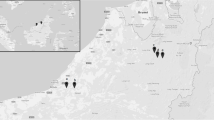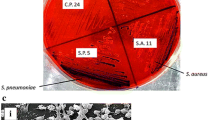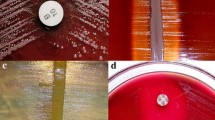Abstract
Objective
To screen for asymptomatic respiratory carriage of S. pneumoniae, H. influenzae and Group A Streptococcus (GAS) in children attending JIPMER, correlate carriage rate with different socio-demographic factors and to detect antimicrobial resistance among the isolates.
Methods
Throat swabs were collected from both in patients and out patients (≤12 yr of age) and processed. Bacteria were identified by Standard techniques. Susceptibility to commonly used antimicrobial agents was determined by Kirby Bauer disc diffusion technique.
Results
Overall carriage rate of respiratory pathogens was 30% with S. pneumoniae, H. influenzae and GAS accounting for 22%, 5% and 4.5% respectively. Three patients had >1 organism. Antibiotic resistance was highest in S. pneumoniae with 66.7% of strains resistant to penicillin. MDR strains were also encountered. Erythromycin resistance was observed in both H. influenzae (28.4%) and GAS (22%). No statistically significant association was found between the carriage rate of these organisms and different socio-demographic factors.
Conclusions
S. pneumoniae carriage rate was comparatively higher in the Community and its antimicrobial resistance is an issue to address.
Similar content being viewed by others
References
Wessels RM. Streptococcal and Enterococcal Infection. In Braunwald E, Kasper D, Fauci A, Hauser S, Longo D, Jameson JL eds. Harrison’s Principles of Internal Mediane, 16th ed, New York; The McGraw-Hill Companies Inc. 2005;823–831.
Kanungo R, Lima D, Rajalakshmi B, Natarajan MK, Badrinath S. Throat carriage of Pneumococci in healthy school children in the Union Territory of Pondicherry. Ind Med Res 2000;112:100–103.
Charmaine AC, Jacob SE, Menon T. Pharyngeal carriage of Group A Streptococci in school children in Chennai. Ind J Med Res 2004;124:195–198.
Masuda K, Masuda R, Nishi JN, Tokuda K, Yoshinaga M, Miyata K. Incidence of nasopharyngeal carriage of respiratory bacterial pathogens in Japanese children attending day care centers. Pediatr Int 2002;44:376.
Gazi H, Kurutepe S, Sürücüoglu S, Teker A, Özbakkaloglu B. Antimicrobial susceptibility of bacterial pathogens in the Oropharynx of healthy school children in Turkey. Ind J Med Res 2004;120:489–494.
Jain A, Kumar P, Awasthi S. High nasopharyngeal carriage of drug resistant Streptococcus pneumoniae and Hemophilus influenzae in Indian school children. Trop Med Int Hlth 2005;10:234–239.
Garcia-Rodriguez JA, Fresnadillo MMJ. Dynamics of nasopharyngeal colonization by potential respiratory pathogens. J Antimicrob Chemotherapy 2002;50:59–73.
Menon T, Shanmugasundaram S, Palani Kumar M, Girish Kumar CP. Group A streptococcal infections of the pharynx in a rural population in south India. Ind Med Res 2004;119:171–173.
Machiso P, Gironi S, Schito GC, Manneli S, Prinicipi N, Esposito S. Seasonal Variation in nasopharyngeal carriage of respiratory pathogens in healthy Italian children attending day care centers or school. JMed Microbiol 2001;50:1095–1099.
Murphy TF. Otitis Media, Bacterial Colonisation and the Smoking parent. Clin Inject Dis 2006;42:904–906.
Greenberg D, Givon-Lavi N, Broides A, Blancovich I, Peled N, Dagan R. The contribution of smoking and exposure to tobacco smoke to Streptococcus pneumoniae and Haemophilus influenzae carriage in children and their mothers. Clin Inject Dis 2006;42:897–903.
Mastro TD, Nomani NK, Ishaq Z et al. Use of nasopharyngeal isolates of S. pneumoniae and H. influenzae from children in Pakistan for surveillance for antimicrobial resistance. Pediatr Inject Dis J 1993;12:824–830.
Melo-Cristino J, Fernandes ML, Serrano N. Antimicrobial susceptibility of Streptococcus pyogenes, Haemophilus influenzae, Streptococcus pneumoniae and Moraxella catarrhalis from Community acquired respiratory infections in 2000. Acta Med Port 2001; 14: 459–168.
Blondeau JM, Tillotson GS. Antimicrobial susceptibility patterns of respiratory pathogens — a global perspective. Seminars in Respiratory Infections 2000;15:195–207.
Author information
Authors and Affiliations
Corresponding author
Rights and permissions
About this article
Cite this article
Dhakal, R., Sujatha, S., Parija, S.C. et al. Asymptomatic colonization of upper respiratory tract by potential bacterial pathogens. Indian J Pediatr 77, 775–778 (2010). https://doi.org/10.1007/s12098-010-0118-x
Received:
Accepted:
Published:
Issue Date:
DOI: https://doi.org/10.1007/s12098-010-0118-x




